
Killing Zombies, Breaking Pipes, and
Other UNIX Shenanigans
Brandon Tweed
CA Technologies
3/13/2012
Session Number: 10980

2
Jurassic Park (1993)

3
Some Background
• Jurassic Park appeared in theaters in 1993.
• That was 19 years ago.
• The girl in the picture is Ariana Richards.
• She will be 33 this year.
• (I used IMDB. I‟m not stalking Ariana Richards)
• Mark Zuckerberg, creator of facebook is 27.

5
The Point
• UNIX awareness was increasing in 1993.
• A lot has happened since 1993
• Google‟s Android OS (Linux-based)
• Apple‟s iOS and OS-X, both derived from UNIX, are also
ubiquitous.
• Java appeared in 1995.
• A generation of developers have grown up with UNIX, Linux,
and Windows available.
• UNIX and Linux are not a fad.
• (Unless you believe a 43-year-old OS counts as a fad)

7
Intermediate Level, You’re Expected to
Know …
• Basic UNIX commands for listing directories and navigation
• UNIX file system and UNIX permissions
• How to access UNIX (via OMVS or preferably puTTY)
• References to keyboard shortcuts assume a puTTY-like
environment, not OMVS.
• The same things can be done from OMVS, but they require
some terminal set-up.
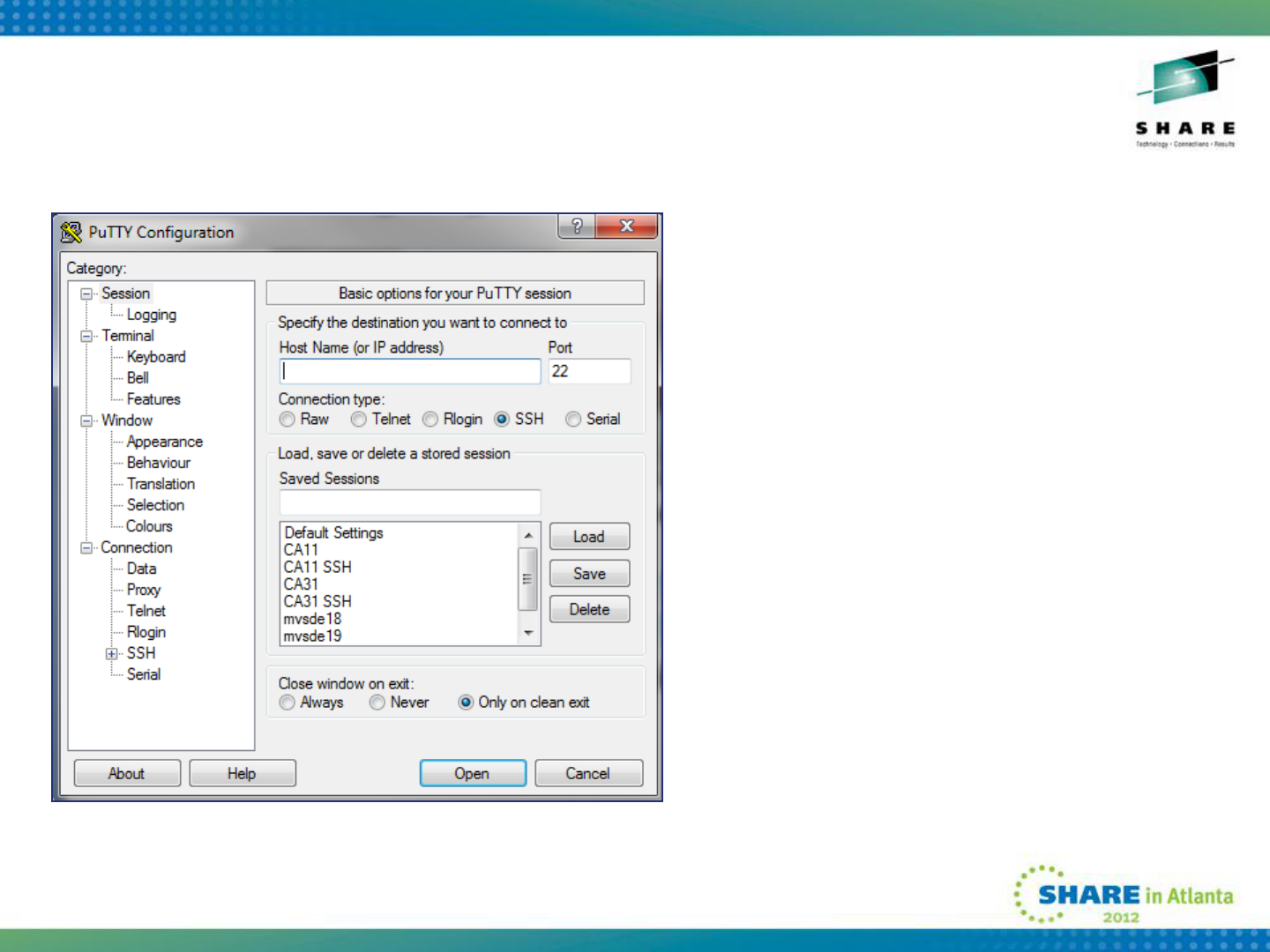
8
puTTY Config Crash Course
1.Provide the hostname
2.Select the connection
type (typically Telnet or
SSH)
3.Ensure that the TCP/IP
Port value is correct
4.Click Open
5.Provide userid
6.Provide password
7.UNIX Prompt! Done.

9
Getting Started - Useful UNIX Commands
• more – displays a text file page-by-page
• grep – search a text file line-by-line for matches to a regex
• wc – word count (can also be used for getting a line count)
• ps – display status information about processes
• find – search the file system for a file
• diff – compare two files line-by-line
• nohup – Run a program that won‟t terminate if your terminal
is disconnected.
• who – see who‟s logged on
• df – report free space for a file system

The “man” Command
• man – access the UNIX manual pages for any given
command.
• Example: man ls
• Gives the manual pages for the ls command
• Yes, “man man” works.
• Note that “man woman” does not.
• Also available: IBM manuals, Google, Bing,
StackExchange, forums, and many other resources on the
web.
10

11
Topic: Killing Zombies

12
UNIX Processes
• Each program running under UNIX is a process
• Every process has a process id (PID)
• Every process has a parent process id (PPID)
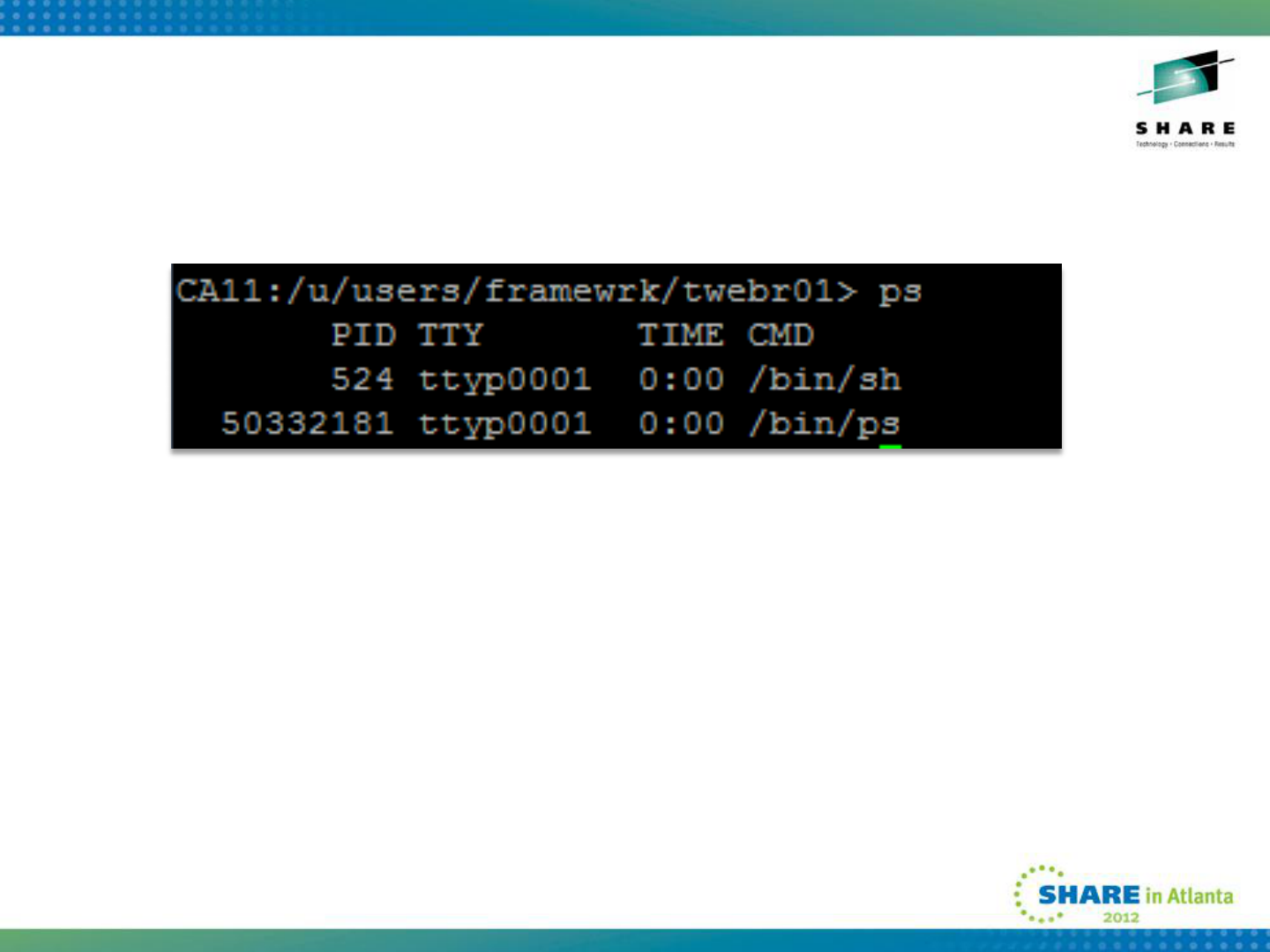
13
Your Processes
• You will have at least one process running under your
userid if you login to USS.
• The process is for your shell (/bin/sh)
• The list also shows the process for ps as it runs.

14
Terminating Processes
• The „kill‟ command can be used to end a running process.
• As always, use with caution.
• Sends the signal SIGTERM to the process.
• This is the polite way of asking the process to end.
• Kill requires the PID of the process you want to terminate.
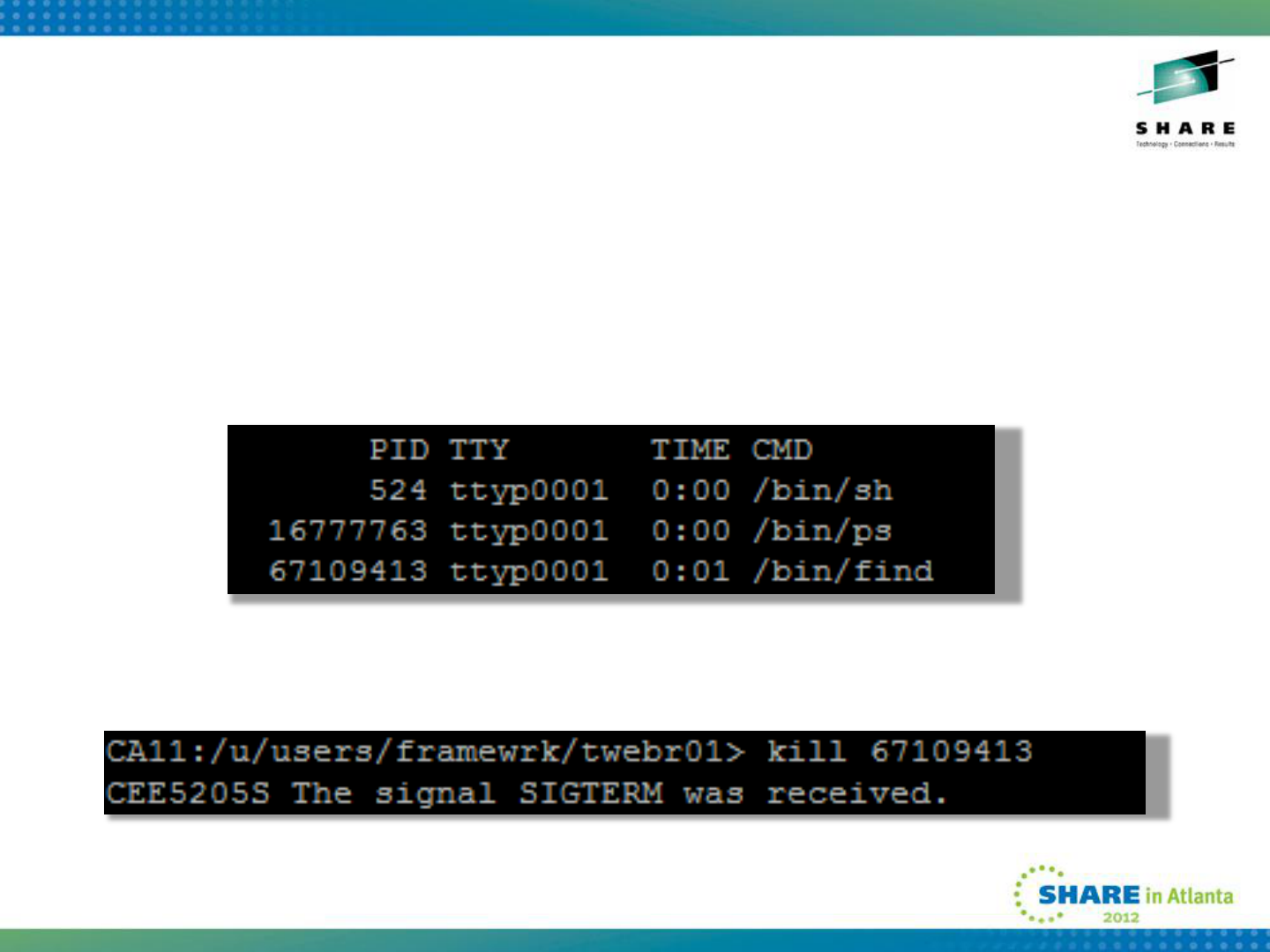
15
How to Kill
1) Use „ps‟ to get the PID of the process
you wish to kill.
2) Assertively issue the „kill‟ command.

16
Terminating with Extreme Prejudice
• In rare situations, a process might ignore the SIGTERM
signal.
• This is usually unintentional behavior.
• Use the –K switch of the kill command to send a “superkill”
signal to the process.
• This should be used as a last resort.
• From the man pages, “The process is ended with a non-
retryable ABEND”

17
What’s a Zombie Process?
It all starts with forking …

18
Fork
• UNIX provides a system call named fork()
• fork() makes an identical copy of the current process
• the original process is called the parent
• the new process is called the child
• the child‟s PPID is the PID of the parent
• The practice is known as “forking”
• In conversations you‟ll hear about “forking a child” or
“forking children”. Try not to be disturbed by this.

How Zombies Are Made
(Forking Without Care)
• Zombies are created through poor programming, usually
during development.
• When a programmer issues a fork() in her program, they
must issue a wait().
• If no wait() is issued, the child process lingers when it
completes execution.
• The process remains in the process table but really isn‟t
doing anything.
19
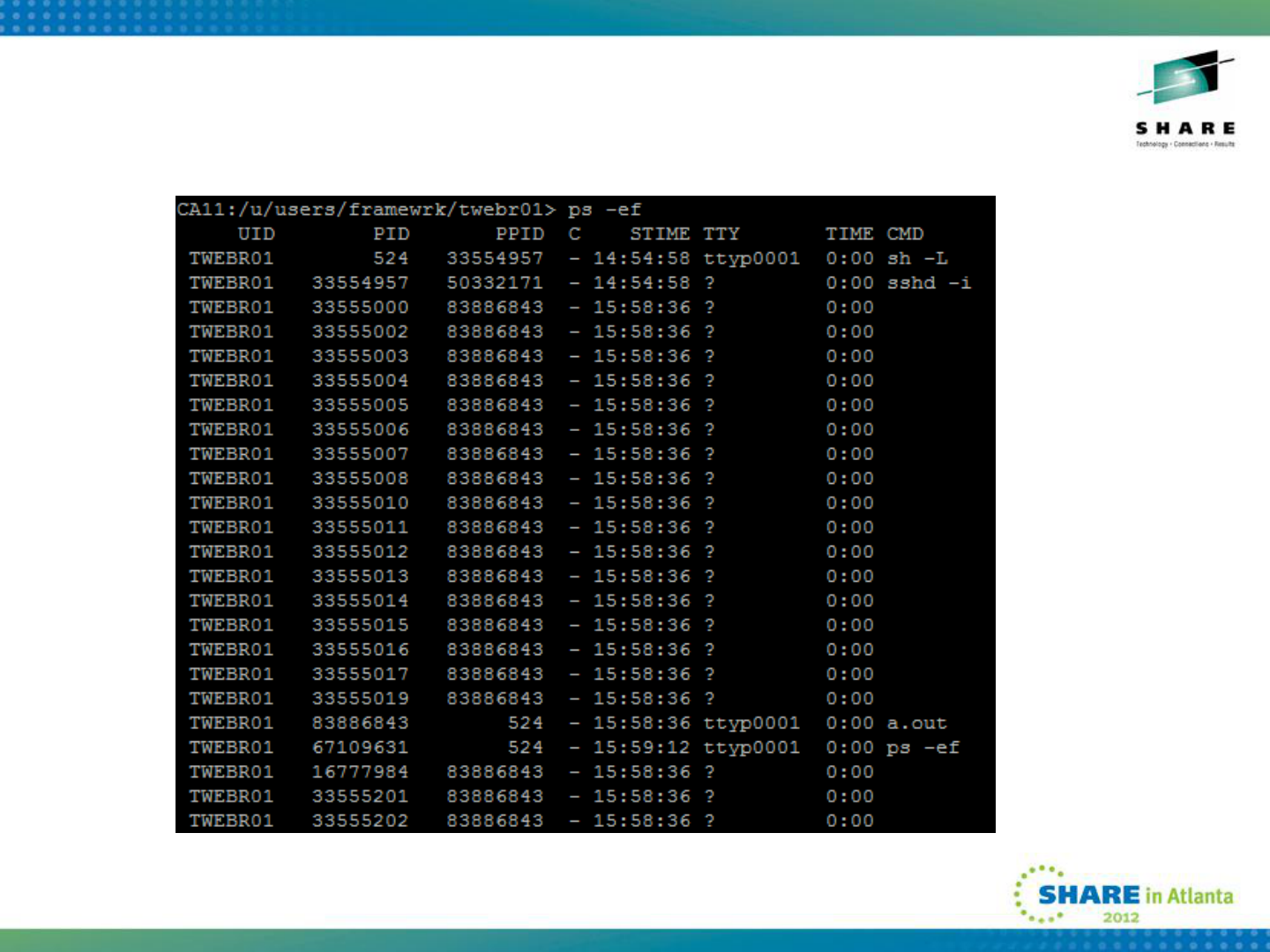
Process Table Full of Zombies
21

The Big Reveal: You Can’t Kill Zombies
22

But Everything is Fine!
• Zombies can‟t be killed?!
• The secret: KILL THE PARENT.
• When the parent dies the init process inherits any
“orphaned” child processes.
• The init process periodically issues a wait() in order to
clean up any zombies.
23

24
Zombie Clean-Up Procedures
1. Use „ps‟ to get the list of
processes
2. Locate the zombie and
determine it‟s PPID
3. Issue „kill‟ to kill the
parent
4. Let the init process take
care of the rest

Prevention: Setting User Process Limit
• Typically done with ulimit command on some UNIX
variants
• For z/OS, this done via the OMVS segment in a user‟s
security profile.
• PROCUSERMAX limits the max number of processes for
the UID.
• More info here:
http://publib.boulder.ibm.com/infocenter/zos/v1r13/topic/co
m.ibm.zos.r13.bpxb200/ussoel.htm#ussoel
25

Topic: UNIX Job Management
• In UNIX a job is a process associated with your
terminal session.
• Jobs can run in the foreground or background.
26

Foreground Processing
• Good for commands/processes that run and
complete quickly
• “hold on” to your command prompt while they are
executing.
• Sort of like online processing with TSO.
27

Background Processing
• Appropriate for things that take a long time to
finish.
• Otherwise you must wait for the command prompt
to appear once the command finishes.
• Similar to batch processing. You run the process
in the “background” and do other things while
you‟re waiting for it to finish.
• Alternative: Have multiple sessions open
28

Running a Command in the Background
• Simple: Append an ampersand (&) to the end of
the command. It will run in the background.
• Example: find / -name profile -print &
29

Example Background Command
find / -name profile -print &
• searches for a file with the name “profile” in it
• starts at the root and prints the results to stdout if
a match is found.
• This will interrupt any interactive commands you
are running to display output.
• Background processes should usually have their
output (stdout and stderr) redirected to a file to
avoid this.
30

Displaying Jobs (Processes)
• The jobs command will give you a list of
processes associated with your session.
• Each process listed will have an associated “jobid”
• The jobid can be used with commands for
managing jobs (such as kill, fg, or bg).
31

Suspending a Foreground Process
• A long-running process in the foreground can be
“suspended” by pressing Ctrl+Z.
• This sends a signal to the process that will pause
it. The process can be resumed at a later time.
• The signal is SIGSTP
32

Foreground Process Suspension
Example
• Try this from a puTTY session, press Ctrl+Z while
the command is running.
• Issuing the “jobs” command will show that the
command is stopped.
33

Resuming a Background Job
• To bring a background job back to foreground
processing, you can issue the “fg” command.
• If you do not specify a job name, it will bring the
most recently suspended job to the foreground.
34

Running a Job In The Background
(Another Way)
• Use the „bg‟ command
• bg jobid
• If no jobid is specified, uses the most recently
stopped job.
• You could run it in the foreground, suspend it,
and then issue bg.
• But there‟s already a better way.
35

36
And Now For Something Completely
Different….
“It is a mistake to think you can solve any major problems
just with potatoes.”
Douglas Adams,
Life, the Universe, and Everything
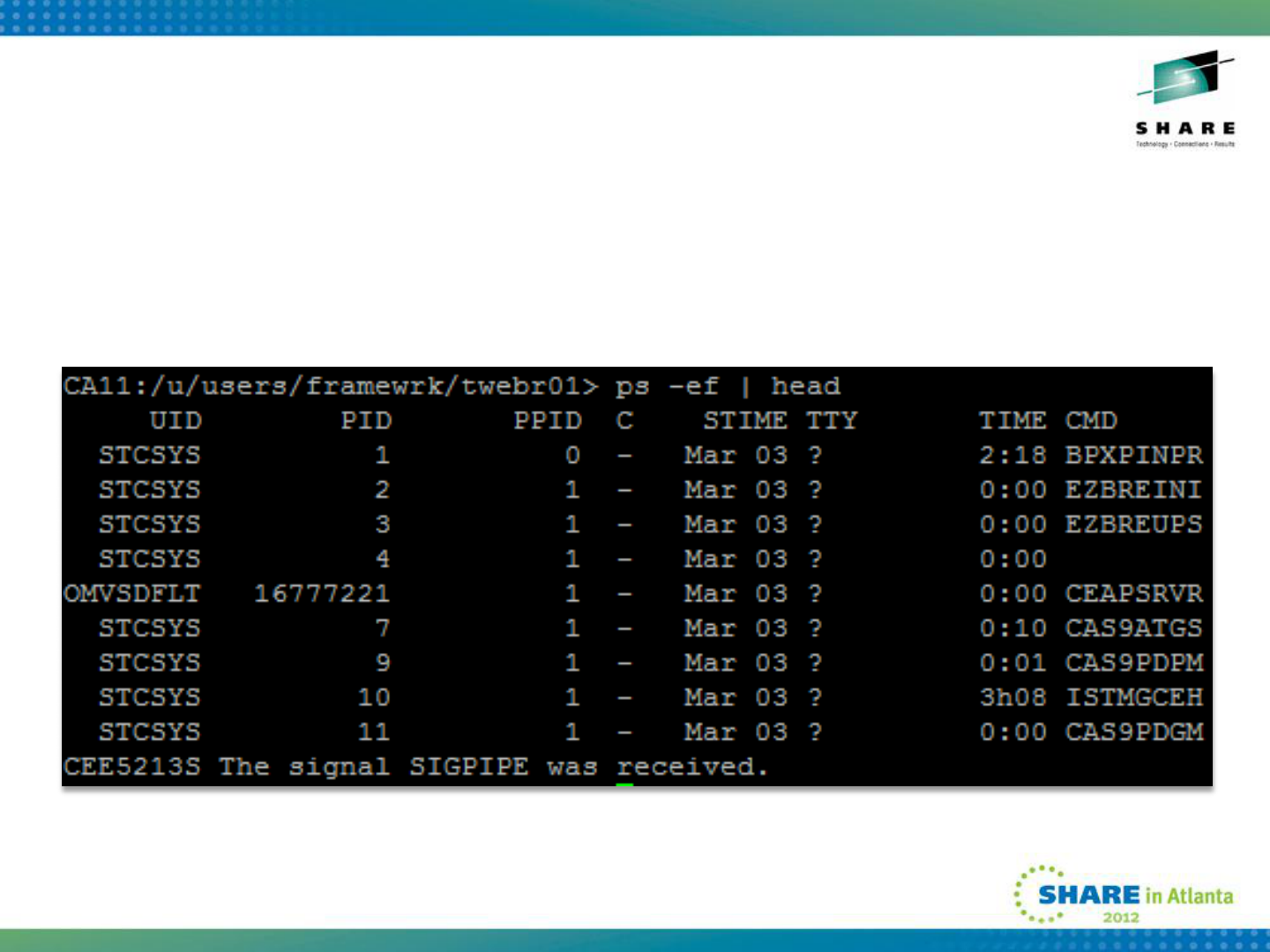
37
Breaking Pipes
• If you experiment with UNIX long enough, you‟ll encounter
this situation although you may not understand why.

Everything Is A File
38
All UNIX processes typically open three files by default:
1. Standard Input (stdin) – Typically direct input from the
terminal, but can come from other places.
2. Standard Output (stdout) – Typically output written to the
terminal.
3. Standard Error (stderr) – Also typically written to the
terminal unless redirected elsewhere.

Related Topic - Redirection
• Earlier we mentioned that each process works
with stdout, stderr, and stdin.
• Each of these is a file that a process opens
automatically when the process begins
executing.
• The output and input of files can be “redirected”
so that it comes from or goes to another place.
39

Topic: Redirection
• Commands refer to stdin, stdout, and stderr by
file descriptor numbers:
• 0 – stdin
• 1 – stdout
• 2 – stderr
40

Redirecting Standard Output
• Save output from a program to a file
• Example: ls –l > listing.txt
• Saves the output of the command to a text file,
listing.txt.
• If this file exists, it will be overwritten
• If it does not exist, it will be created
• (as long as the permissions allow this)
41

Redirecting Standard Input
• Some commands read from standard input.
• You may want to provide a file as input instead
of typing data.
• Better example in UNIX Shenanigans.
42

Redirecting Standard Input (Example 1)
• cat < file.txt
• This feeds the file “file.txt” as input to the „cat‟
command.
• Example is silly because you can provide a file
name as an argument to the cat command.
43

Redirecting Standard Input (Example 2)
Example: sh < script.sh
• create a new shell instance with the sh
command
• feed it script.sh as the input.
• running a shell script but in a non-conventional
way
44

Remembering How to Redirect
• For simple redirection, pretty easy to remember
• The “<“ or “>” points to where the data is going.
• who > file.txt
• cat < file.txt
45

Redirecting ALL The Output
Example: command > file.txt 2>&1
• Redirects stdout to file.txt
• Redirects stderr to stdout
• Result: Both stdout and stderr written to same
file.
• „command‟ can be any UNIX command
46

Next: Pipes
47
“A common mistake that people make when trying to design
something completely foolproof is to underestimate the
ingenuity of complete fools.”
- Douglas Adams, The Hitchiker‟s Guide to the Galaxy

Pipes
48
• Transfer data between
UNIX processes. The
output of one process
becomes the input to
another.
• Alternative to pipes:
Create a file as output
from each command, then
feed the file as input to a
subsequent command.

Using Pipes
49
String together commands using the „|‟ character (X‟4F‟ or
0x4F).
Example:
who | grep userid
Output of the „who‟ command is given as input to the grep
command. Grep will search it for a match for <userid>.

A Side Note On Grep
50
• Grep is an incredibly useful tool.
• Learning regular expressions makes it even more
powerful.
• Regular expressions aren‟t the purpose of this session.
• There are many great books and online resources that
explain regular expressions very well.
• Regular expressions are also useful for other tools,
commands, and editors (sed, awk, vi, et cetera)

Looking Closer
51
Example:
who | grep userid
1. The who command writes its output to stdout (normally
goes directly to the terminal).
2. The pipe forces the output of the who command to
become the input of the next command, grep. (The
stdout of the „who‟ command becomes the stdin of the
grep command.)
3. grep reads the input and uses it for its search

More Pipe Examples
52
ls -l | more
Display the output of a long listing page-by-page.
who | wc -l
Count the number of UNIX sessions.
who | sort
Sort the output of who (displays lines in alphabetical order)

More Pipe Examples (2)
53
ls -l | grep ‘^d’
Obtain a listing that includes only directories.
find . -name *.c | grep hello
Search recursively from the current directory downward for
files with names that end in “.c”then filter that list to include
only filenames with “hello” in them. (Modify the command to
make it useful)

More Pipe Examples (3)
54
ps -a -o pid= | wc -l
Get the list of all processes (that you‟re allowed to know
about) and give the count of the list produced. End result:
count of processes running that you‟re allowed to see by
security.
env | grep ‘^a’
Search all UNIX environment variable definitions to find
names that begin with „A‟ or „a‟.

What’s a broken pipe?
55
• One of the commands in a string of piped commands has
its input (stdio) or output (stdout) closed or EOF
• Example scenario:
• a command pipes its output (stdout) into another command
• the receiving command closes stdin before all the input is
received
• the pipe is “broken”, the sender has nowhere to write the
data

Example C Program
56
#include<stdio.h>
int main(void) {
fclose(stdin);
return 0;
}
• The program closes standard input (stdin) immediately
and then ends with an RC = 0.
• A program feeding the right amount of input to this
through a pipe will result in SIGPIPE (broken pipe)

Example Run
57
• The compiled program (a.out) immediately closes stdin
when it starts.
• The ls command tries to continue writing to stdout, which
has been closed, and receives the SIGPIPE signal and
terminates processing.

Are Broken Pipes A Problem?
• Yes, if you‟re developing a program that doesn‟t
handle stdin/stdout/stderr correctly.
• When working with standard UNIX commands,
not really a big issue.
• Correct the command, try again, and move on
with life.
• Now you know more about what SIGPIPE
actually means.
58

Other UNIX Shenanigans
59

UNIX Shenanigans
• Experimenting with UNIX commands is often the
best way to learn about them.
• This can yield some unexpected results.
• I don‟t endorse doing things that are actually
malicious/harmful to your system.
• However, I do take great pleasure from causing
harmless mischief.
• Don‟t try this at home unless you claim full
personal responsibility for it.
60

UNIX Shenanigans - wall
61
wall - Send a broadcast message to all logged-in UNIX
users.
• Requires superuser or permission to write to the
terminals of others
• Takes input from stdin. Use a pipe to feed whatever file
you like to the wall command.
• Maybe try sending War and Peace to all the users?

62
UNIX Shenanigans – logger
logger - send a message to the console log

63
UNIX Shenanigans - logger
Send an entire file to the console.

64
UNIX Shenanigans – kill
Not fond of someone? Kick them off the system!
• Typically requires superuser
• Traceable
1. Use ps to find the PID of their shell (grep the output
if you have to)
2. Issue the kill command with the PID of the shell
Example: kill -HUP 33554862

65
UNIX Shenanigans – talk
talk userid
• Establishes a two-way chat session.
• Requires acceptance from whoever you‟re trying to
chat with.
• Disruptive to work and agitating if done repeatedly.

66
UNIX Shenanigans – write
write userid terminal
• More assertive than talk
• Input comes from stdin
• Written to receiver‟s terminal without asking
• Very disruptive! (Much like e-mail and instant
messenger)
Example:
cat file.txt | write twebr01 ttyp0020

67
Other Mean Tricks
Add „umask 777‟ to another user‟s .profile.
• Sets the permissions for newly created files or
directories to 000.
• Won‟t be able to read, write, or execute files or
directories created.
• Directories created this way can‟t be listed by the
user .
• Change won‟t be noticed unless user checks his/her
profile.
• Even better, add this to /etc/.profile

68
Other Mean Tricks
Make a user think all her files are gone.
1) Create an empty zfs (size doesn‟t matter), use
ISHELL for conveniece
2) Mount it on top of their home directory, use ISHELL
if you‟re not sure how to use the mount command
3) User‟s home directory will appear to be empty.
Files are still there but inaccessible until the zfs is
unmounted.

69
Other Mean Tricks
Prevent a user from logging in – add “exit” statement
to their .profile.
• Requires write access to .profile or superuser
• When the session starts, it will immediately end.
• Very annoying.
• Use ISPF option 3.17 to open the file outside of USS
and remove the exit statement if you try this with
your own .profile.

70
Why Would You Do This??
• At some point, someone will knowingly or
accidentally do something to cause trouble in UNIX.
• Real Example:
• Statement added to /etc/.profile that causes an error
(unintentional)
• Error prevents user‟s .profile loading for all users
• Broke a number of UNIX build processes.
• When something like this happens, you‟ll be
equipped to diagnose/fix problems.
• By causing trouble, you also learn how to fix
problems

Conclusion
• Common UNIX
commands
• puTTY set-up
• Processes
• Zombies
• Pipes
• Job Management
• I/O Redirection
• Causing Trouble
71

72
Mischief Managed (Q&A)



